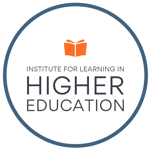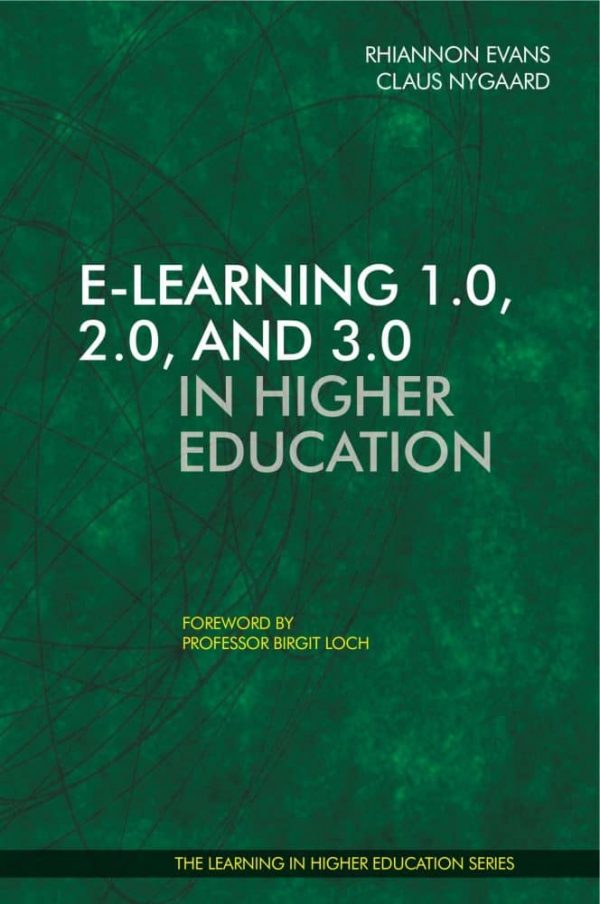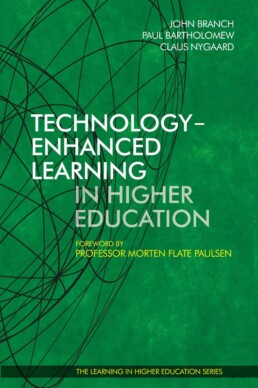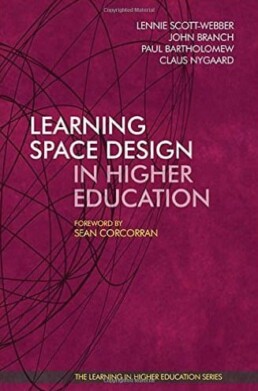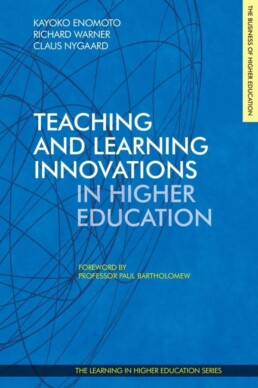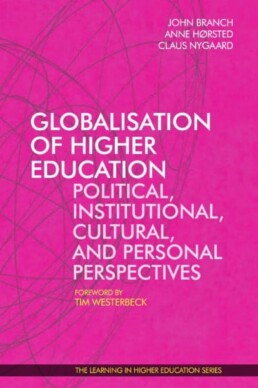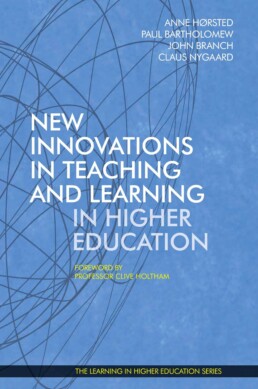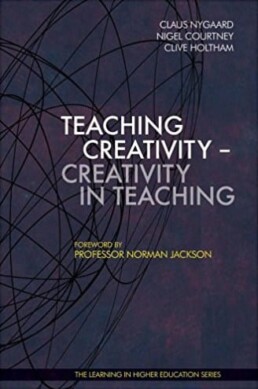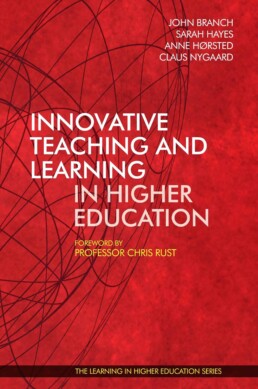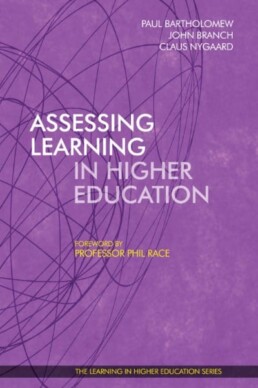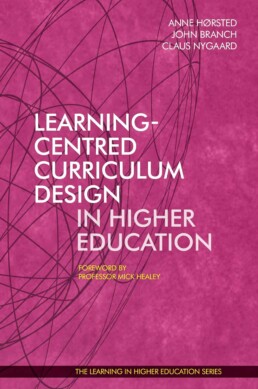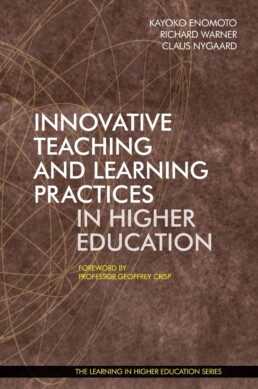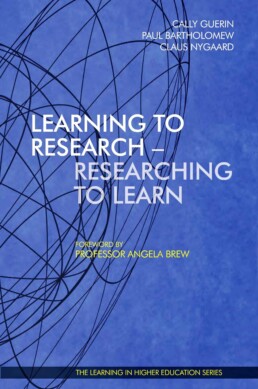E-learning in Higher Education, 1.0, 2.0, and 3.0 (BOOK)
E-learning 1.0, 2.0, and 3.0 in Higher Education guides the reader through the design and use of e-learning in higher education, referring to the book’s central framework. Readers are invited to reflect on the learning theories underlying their own design practices for e-learning in higher education. The book introduces eight practical examples of e-learning design considerations and e-learning implementations as academic colleagues worldwide present their concrete use-cases of e-learning technologies.
E-learning 1.0, 2.0, and 3.0 will enable readers to use the framework for e-learning and its link to associated learning theories to inform their own design and use of e-learning technologies – for the benefit not only of teachers but also the engagement and learning of students.
98 in stock
Description
E-learning in Higher Education: three perspectives, 1.0, 2.0, and 3.0
Are you prepared for a completely new take on e-learning in higher education?
Then read this book on e-learning in higher education!
As you read this book, you are introduced to a novel framework for e-learning in higher education, which links three types of e-learning to three learning perceptions.
In the book, the authors distinguish between these three types of e-learning in higher education:
- e-learning 1.0 (distribution),
- e-learning 2.0 (dialogue), and
- e-learning 3.0 (construction).
In their framework, they actively link the use of e-learning in higher education to three theoretical perceptions of learning:
- e-learning 1.0 (behavioural learning theory),
- e-learning 2.0 (cognitive learning theory), and
- e-learning 3.0 (social learning theory).
This book guides you to a well-informed design and use of e-learning in Higher Education
By its novel framework for e-learning, the book E-learning 1.0, 2.0, and 3.0 in Higher Education guides you to a well-informed design and use of e-learning activities in higher education.
As you read, you are invited to reflect on your e-learning practice.
- Do you use e-learning mainly as a way to distribute information to students in the digital domain?
- Do you use e-learning as a way to enhance online communication between learners?
- Do you use e-learning as a way to develop the academic identity of students?
Most often, best practice is reflected practice
The book introduces eight examples of reflected practice as faculty members share their use-cases of e-learning technologies. Reading their examples of e-learning design, you are invited to reflect on your design of e-learning in higher education.
Therefore, reading the book may be beneficial to you, as its framework for e-learning and its use-cases may well inspire you to reflect more carefully about your e-learning practice.
E-learning 1.0, 2.0, and 3.0 in Higher Education will enable you to use its novel framework for e-learning and its link to associated learning theories to inform your design and use of e-learning technologies – for the benefit not only of you as a teacher but more importantly for the engagement and learning outcomes of your students.

Pages: 248
Published: 2019
ISBN: 9781911450399
About the Editors
Rhiannon Evans is Senior Lecturer in Classics and Ancient History at La Trobe University, Melbourne, Australia. She has pioneered the use of e-learning within her academic field.
Professor Claus Nygaard is Executive Director at Institute for Learning in Higher Education, Denmark; Adjunct Professor at Copenhagen Business School, Denmark; Adjunct Professor at the University of Aarhus Denmark; Visiting Professor at Stockholm School of Economics Riga, Latvia. Expert in Management Education and learning-centred higher education.
Overview of this book about e-learning in higher education
- Chapter 1: An Introduction to e-learning in higher education: 1.0, 2.0, and 3.0. Malinda Hoskins Lloyd, Willie McGuire, Reya Saliba, Rachid Bendriss, Flemming Meier, Rhiannon Evans, and Claus Nygaard (pp. 1-22)
- Chapter 2: E-learning as a strategy for improving university students’ learning outcomes. Claus Nygaard (pp. 23-44).
- Chapter 3: Using a peer-centred online learning platform to support students’ academic-professional transition. Willie McGuire and Olan Harrington (pp. 45-72).
- Chapter 4: The effectiveness of e-learning in Business Communication at the University of Johannesburg? What students say! Magas R. Pather (pp.73-100).
- Chapter 5: Using WordPress, Canvas LMS, Dropbox and Facebook to enhance students’ online engagement in postgraduate education. Anne Hørsted (pp.101-114).
- Chapter 6: Using e-learning to improve the student experience of lectures. Rhiannon Evans (pp. 115-136).
- Chapter 7: The E-CIL framework: an instructional practice for promoting student engagement with content, the instructor, and other learners in online courses. Malinda Hoskins Lloyd (pp. 137-164).
- Chapter 8: Experiential learning in premedical education: enhancing students’ experience through e-learning. Reya Saliba & Rachid Bendriss (pp. 165-188).
- Chapter 9: Ten e-learning technologies to support problem-based collaborative work. Flemming Meier & Claus Nygaard (pp. 189-210).
- Chapter 10: Using e-learning to supervise students’ project work in higher education: some pedagogical requirements.Flemming Meier (pp. 211-228).
A detailed description of the chapters in this book about E-learning in Higher Education
Chapter 2, E-learning as a strategy for improving university students’ learning outcomes, is written by Claus Nygaard.
In this chapter, Claus discusses three different learning theories (behaviourist theory of learning, the cognitive theory of learning, and the social theory of learning). He links them to three types of e-learning 1.0 (distribution), 2.0 (dialogue), 3.0 (construction).
His main argument is that a theoretical understanding of learning must inform any choice of e-learning technology because the “e” in itself does not lead to learning.
If we aim to improve students’ learning outcomes using e-learning, our strategy for using e-learning technologies must be motivated by learning theory.
The most important lesson from his chapter is that when you design curricula for e-learning, three essential questions have to guide your work:
- how do you perceive learning?
- how do you perceive e-learning?
- how do you perceive curriculum?
Those three questions form the basis of your e-learning strategy and help you design a curriculum using e-learning, improving students’ learning outcomes.
Claus’ chapter is an inspiring read because it makes us reflect on our choice of e-learning technology’s theoretical underpinnings.
Thus, the novel framework of e-learning 1.0, 2.0, and 3.0 helps us make well-considered decisions on designing a curriculum for e-learning.
Reading Claus’ chapter, you will:
- be presented with a central typology for e-learning, which distinguishes between e-learning 1.0, 2.0, and 3.0;
- be introduced to learning theory and discussions of how different approaches to learning may have implications for your understanding of students’ learning outcomes;
- be invited to reflect on your curriculum design when using e-learning, to improve students’ learning outcomes.
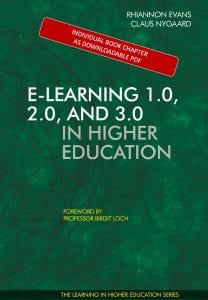
–oOo–
Chapter 3, Using a peer-centred online learning platform to support students’ academic-professional transition, is written by Willie McGuire and Olan Harrington
In their chapter, William and Olan present an alumni project called Teaching-Jobs. It attempts to shift students from their current dialogical state (e-learning 2.0) to a constructional state (e-learning 3.0).
This shift is particularly evident in one of the project’s key aims: creating a self-sustaining support model for future alumni using peer mentoring to develop student ownership of the resource and its future iterations.
Their chapter addresses a current issue in the transition from initial teacher qualified status to fully qualified status.
The authors conduct a literature review using two case studies to highlight the need to develop an evidence-based rationale for using a blended learning constructivist pedagogy to support this transition and enhance subject-specific knowledge essential to the development. One of the critical lessons echoes Mick Jagger’s words: “You can’t always get what you want,” as the authors found that there was a considerable gap between their expectations of how students might use the e-learning resource and the reality of its deployment.
Reading Willie’s and Olan’s chapter, you may take away three insights:
- the reasons why they created the peer-centred online learning platform to support students’ academic-professional transition;
- two critical modes of support: dialogue with peers and access to the online support materials;
- learn about their attempts to create a self-perpetuating system, by which they mean a resource, which once established, would then be controlled exclusively by alumni for alumni.
–oOo–
Chapter 4, The effectiveness of e-learning in Business Communication at the University of Johannesburg? What students say!, is written by Magas R. Pather
Magas discusses the effectiveness of E-learning from an African perspective. In the chapter, students offer their perceptions of E-learning’s effectiveness in a course in Business Communication given at the University of Johannesburg in South Africa. Although African countries experience constricting factors using technology in education, E-learning is not new to them, Magas reports. At the University of Johannesburg, although E-learning has been welcomed in the learning space, there is insufficient information on its effectiveness. Some immediate questions arise: What works? What doesn’t work? And why?
In his chapter, Magas seeks to answer the central question: “Do students learn more when using E-learning compared to face-to-face learning?” He consults his students and let them have their say. The chapter uses qualitative research methods drawing on both questionnaires and one-on-one interviews to ascertain the students’ views.
Reading the chapter, you will gain awareness about:
- E-learning for Business Communication from an African perspective;
- E-learning as a pedagogical and practical tool for Business Communication;
- students perceptions about the effectiveness of E-learning for the Business Communication course.
–oOo–
Chapter 5, Using WordPress, Canvas LMS, Dropbox and Facebook to enhance students’ online engagement in postgraduate education, is written by Anne Hørsted
Anne focuses on how a group of teachers in a postgraduate training program, Camp Future, have changed their use of technological platforms for three years and how those changes have affected students’ online engagement. Instead of going into technical details, she reflects the teachers’ technological choices using the typology of e-learning 1.0, 2.0, and 3.0.
Her main argument is that it is essential that we, as teachers, discuss the use of scenarios of e-learning before implementing a technological platform.
Had the teachers at the program Camp Future given themselves time to discuss the use scenarios in a pedagogical and technical perspective with former and current students, they most likely would not have changed technological platforms three times in three years.
Reading Anne’s chapter, you will:
- get an introduction to a postgraduate training program, which actively links unemployed university graduates with private businesses and lead to the creation of jobs;
- hear about the experiences with the use of different technological platforms to enhance student engagement; and
- reflect on strengths and weaknesses of using different e-learning technologies seen in the light of the typology of e-learning 1.0, 2.0, and 3.0.
–oOo–
Chapter 6, Using e-learning in higher education to improve the student experience of lectures, is written by Rhiannon Evans
She focuses on how automated lecture recording in lecture theatres has affected student attendance and engagement and suggests one possible e-learning solution to this problem. Her main argument is that the ‘one-size-fits-all’ solution of institutional lecture recording has resulted in low student engagement. The majority of the class does not utilise these poorly produced recordings.
A more customised solution is to abandon live performances and to pre-record video lectures. This also allows for a more segmented material presentation in shorter ‘chunks’ (making e-learning 1.0 more attractive).
Students are then asked to complete tasks in response to the material in the short recordings (e-learning 2.0) and ultimately construct their research project and a version of the presentation modelled to them (moving towards e-learning 3.0).
The most important lesson in her chapter is that e-learning tools as an add-on to traditional teaching do not automatically improve students’ learning. Thought should be given to how best to present material and how much material needs to be presented. Her chapter should inspire other teachers by showing them how to make relatively small changes to content delivery, appropriate to their own students’ context, and transform student engagement and assessment.
Reading Rhiannon’s chapter, you may gain the following three insights:
- the potential gains and losses of theatre-recorded lectures;
- the means to provide successful pre-recorded material for students;
- how pre-recording provides a model for student adoption of e-learning technologies and allows for customisation of the curriculum.
–oOo–
Chapter 7, The E-CIL framework: an instructional practice for promoting student engagement with content, the instructor, and other learners in online courses, is written by Malinda Hoskins Lloyd
She focuses on how teachers can use the E-CIL Framework to foster higher education students’ learning. The instructional framework was designed to create an online learning environment during which higher education students engage with three critical components in online courses–the content, the instructor, and co-learners. Her chapter’s main argument is that students need to interact with each of these components in courses to positively affect students’ online experiences and, ultimately, their academic achievement.
The most important lesson of the chapter is that students can utilise e-learning tools such as Nearpod, Flipgrid, and Padlet (or other current tools) to foster interactions between students and the content they are learning, as well as interactions with the instructor of the course and other learners also taking the course. She hopes her chapter is an inspiring read for other educators because the E-CIL Framework information applies to any course and multiple disciplines. Although this framework was designed for online courses, it may also be implemented to enhance face-to-face and blended courses. Reading Malinda’s chapter, you may learn how:
- they increase students’ engagement with content, with the instructor, and with co-learners;
- they increase students’ sense of belonging to a learning community in an online course;
- a course can be effectively designed with weekly guidelines of specific components to be included.
–oOo–
Chapter 8, Experiential learning in premedical education: enhancing students’ experience through e-learning, is written by Reya Saliba & Rachid Bendriss
They focus on teachers and learners’ experience by designing and implementing an experiential learning project aimed at introducing students to a community of practice. Immersed in this community, students are inspired to share knowledge.
Their main argument is that experiential learning provides a unique opportunity to bridge the gap between theoretical concepts delivered through traditional methods and real-world inspiration facilitated through e-learning and experienced in real-life settings.
The most important lesson in their chapter is the vital role experiential learning plays within a blended curriculum to complement e-learning methods with face-to-face application of concepts in the real world. Their chapter is an inspiring read because it shares an innovative andragogic practice with hands-on teaching steps to conceptualise and implement experiential learning in a higher education course curriculum. Using e-learning to facilitate instruction, the chapter provides practical tools that incorporate information literacy in an advanced English communication course while challenging learners to critically reflect on their experiential learning within a community of practice.
Reading Reya’s and Rachid’s chapter, you may:
- learn how to design an Experiential Learning project as an integral component of a university blended course;
- understand the role of e-learning in facilitating knowledge gain and effective communication between instructors and students;
- gain insight into the opportunities and challenges that faculty and students encounter while engaging in an e-learning environment.
–oOo–
Chapter 9, Ten e-learning technologies to support problem-based collaborative work, is written by Flemming Meier & Claus Nygaard
They discuss how students may use e-learning to support problem-based collaborative work. By introducing e-learning into the pedagogical debate of problem-based collaborative work, they aim to show what e-learning tools and practices are available to support problem-based collaborative work.
Their chapter raises awareness of some of the positive consequences of linking together e-learning technology with learning theory. They believe that faculty members and those responsible for implementing e-learning technologies may use their chapter to frame a broader debate on the choice and use of e-learning technology.
They see their chapter as being introductory rather than exhaustive. They cover problem-based collaborative work, learning theory and e-learning technologies. Still, they do so to raise awareness of how they are possibly linked, not to mirror a text-book on any of these issues.
Reading Flemming’s and Claus’s chapter, you may:
- gain an understanding of problem-based collaborative work as a pedagogical practice;
- familiarise yourself with social learning theory and its understanding of ways in which students learn;
- see examples of how e-learning may support problem-based collaborative work when being based on social learning theory.
–oOo–
Chapter 10, Using e-learning in higher education to supervise students’ project work: some pedagogical requirements, is written by Flemming Meier
He discusses the pedagogical requirements linked to the selection and application of e-learning. Using e-learning concerning students’ project work supervision is relevant, Flemming argues, because more and more universities face demands to economise on teachers’ critical face-to-face time to supervise students. He uses the typology of e-learning 1.0, 2.0, and 3.0 to apply a specific structure to his reflections about ways in which technologies might help to mediate the distribution of texts and other resources (e-learning 1.0); mediate spaces for conversation and dialogue (e-learning 2.0); and, mediate workspaces in which students produce (construct) parts and pieces that go into projects (e-learning 3.0).
Reading Flemming’s chapter, you may gain: 1) knowledge of the pedagogy related to project work and supervision; 2) inspiration regarding how digital technologies may be integrated into supervision processes.
Reading Flemming’s chapter, you may:
- gain knowledge of pedagogy related to project work and supervision;
- get inspiration as to how digital technologies may be integrated into supervision processes.
